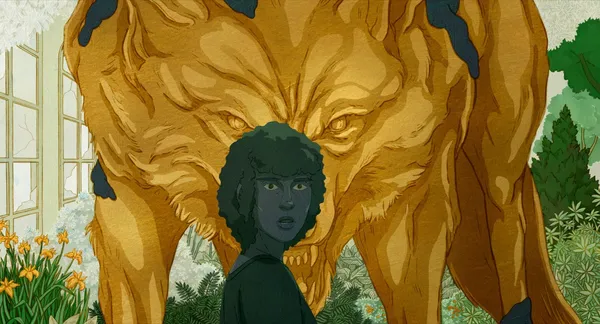Eye For Film >> Movies >> Death Does Not Exist (2025) Film Review
Death Does Not Exist
Reviewed by: Sergiu Inizian

Standing on a cliff, Hélène (voiced by Zeneb Blanchet) gazes down at an imposing estate, with a glass structure throned in its middle. She watches on as the building begins contorting and swelling, before being torn apart by an explosion of vegetation growing from within. Resembling a slithering black avalanche, it spills to the nearby town, poised to swallow a world that stands on the precipice. She hears a voice, giving meaning to this terrific vision – "A great upheaval, something new." The cataclysm shocks Hélène, pushing her to question her convictions about violent uprising. Félix Dufour-Laperrière's new feature depicts this conflicted inner space as an unrestrained animated canvas, where colour and texture resonate with rhythms of violence, repression and hope, revealing familiar dilemmas in an alien environment.
Protected by the shade of the nearby forest, Hélène and the other freedom fighters prepare to attack the glass mansion. She offers a rousing speech about their simple objective: kill the affluent oppressors who subjugate ordinary people and mistreat nature. Laperrière and his team tie the 2D digitally crafted characters to the hand-painted landscape, with human silhouettes borrowing the background chromatic. As they approach the estate, the porcelain-tinted world of the wealthy imposes its sterile glow on the freedom fighters. Hélène becomes uneasy about the attack, especially as Marc (voiced by Mattis Savard-Verhoeven), another dissident, professes his love for her, a mutual feeling she represses. Finding herself unable to act when the time comes, the protagonist runs back to the shelter of the forest, looking back as the guards kill her companions.

Under a paper-coloured morning light, Hélène is woken up by Manon (voiced by Karelle Tremblay), her fellow fighter, who is surprisingly unharmed. She dismisses Hélène's questions about her survival, instead offering her a chance to redeem herself for her cowardice. As the journey transports the two deeper into the forest, and the hours go by, pale tones make way for a rich sequence of colours, finally arriving at coppery red reflected on Manon's visage. Around a campfire, she expresses her vision of necessary violence, her soliloquy placing more weight on the shoulders of a conflicted Hélène. Contrasting the bloody hue that engulfs the night, her green eyes command attention and transport the narrative into a world defined by her conviction - only the strong survive when struggling against the oppressive.
Laperrière's focus is on creating a sensorial experience, allowing the narrative to become somewhat murky. Texture acts as a key motif in creating contrast between the freedom fighters and the wealthy oppressors. Hélène's world finds itself marked by the presence of fragile, torn flesh, a visceral setting where Manon’s wound suddenly resurfaces as a pulsating red waterfall. In contradiction to this hurting yet natural environment, the estate is decorated by a series of golden statues, some of which depict the wolves encountered by Hélène as they gorge on a sheep’s carcass. The uncanny sight of the immovable animals is heightened by Jean L'Appeau's score, built around bells, violins and other eerie string arrangements - an urgent ensemble that demands action out of the characters. But the world of the unnamed landowners remains deeply rooted and motionless, clashing with the dynamism through which the freedom fighters act to create a better world.
Hélène's surroundings become increasingly strange as she contemplates returning to the mansion to finish the job. As she meets her child version in a garden adorned with orange, white and red flowers, she enters a universe which bypasses the rules of time and space. Transported to her home, she sees her parents in a kitchen lit in a faint blue tint. They seem tired but content they are together. Laperrière creates a space in which memory and intimate warmth offer Hélène a moment of respite from the violence that seems to slowly engulf her. And yet, the biting presence of Manon and an authoritative door-knocking act wakes the protagonist from this reverie.
As she is still unsure, her friend volunteers to show her what she is perhaps most afraid of. In a break from his stylistic conventions, Laperrière employs a minimalist style that explores Hélène's innermost headspace, where he contemplates her love for Marc, who might still be alive. A hand-drawn sketch of him appears against a flat golden background. He resembles the statues from the estate's garden, yet he speaks with affection of a dream he had about their life together. Hélène, off-screen, expresses her hope for a normal, even boring future. We see drawings of a watch, a record player, of books - everyday objects that seem like artefacts from the future. One that is marked by uncertainty.
Within the otherworldly universe in which even the concept of finality is challenged, Laperrière creates an allegory about personal resilience and collective action that seems to be driven by cycles of both violence and love. While at times vague, Death Does Not Exist creates a richly textured narrative where immediate decisions must be made, inviting meditation on freedom, choice and whether cycles can be broken without an immediate deluge of consequences.
Reviewed on: 15 May 2025
















